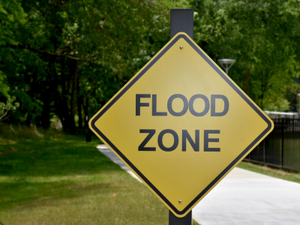Flood Zones in Florida
Imagine finding your dream home close to the beach, with a pool, and on a canal for under $1 million. Sounds perfect, right? Before you fall in love, there’s something crucial you need to know before considering purchasing a home on the coast: flood zones.
Many homebuyers relocating to the St. Augustine area search online for homes, see a beautiful property within walking distance to the beach or on a canal, and think, “Wow, what a great deal!” Then they call us to book a showing, and we enlighten them about the flood zone the house is located in. Today, we’re going to dive into how to find the flood-prone areas in St. Augustine so you can learn more about this critical aspect of homebuying in Florida.
 Why Flood Zones Matter in St. Augustine
Why Flood Zones Matter in St. Augustine
St. Johns County is ranked in the top 10 for high flood risk in the nation. This makes understanding flood zones even more essential when purchasing a home here.
How to Find Your Flood Zone
If you find a home or area that you like and are unsure of the flood zone, one of the first steps is to check the FEMA Flood Maps. It’s an easy-to-use online tool that shows you which areas are prone to flooding. You can plug in the address of a house you’re interested in and see what flood zone that specific property is in.
You can also ask the homeowner if they have an elevation certificate. This document will tell you the elevation above sea level, starting at the lowest grade including structural supports to the top of the first floor.
 New Disclosure Law in Florida
New Disclosure Law in Florida
Florida Governor Ron DeSantis recently signed a bill (HB 1049) into law, requiring sellers to disclose significant details about their property’s flood risks. This includes insurance claims related to flood damage and any federal assistance received. This law takes effect on October 1, 2024, and aims to increase transparency for buyers.
This new law is a game-changer. With storms becoming more frequent and intense, knowing a home’s flood history is crucial. This transparency helps you make informed decisions and better protect your investment.
Flood Zones in St. Augustine: A Case Study
Davis Shores is a historic neighborhood and continues to be popular for many reasons. It’s close to downtown, Anastasia State Park, and the lighthouse. The homes vary in size, and you’ll find cottages from the 1920s to cool mid-century modern homes and newer contemporary homes.
Davis Shores is located in flood zone AE. Here’s why: until the 1920s, this area was a swampy lowland. A wealthy developer, D.P. Davis, purchased the lowlands and had big plans for the area, which underwent a massive 1,500-acre dredge and fill operation. Unfortunately, this land is still low-lying and is susceptible to flooding.
Since this area is Flood zone AE and is prone to flooding, Elevation matters. Homes that sit higher have a better chance of staying dry during a storm. For example, check out this home built in 2015 in a well-known flood-prone area. It sits over 9 feet above sea level and has never flooded.
However, keep in mind that if a home is located in flood zone AE and has never flooded, chances are the property around the home has. You’ll need to consider the elevation of the garage and driveway to ensure your cars stay dry in a flood.
 Flood Insurance Requirements
Flood Insurance Requirements
If you are in high-risk flood zones, such as Zone A, AE, and V, which indicate areas that have a 1% or greater chance of flooding in any given year, you will be required to get flood insurance despite your home’s elevation. If your home sits higher and has never flooded, then the insurance will be less than a home that sits lower and has a history of water intrusion.
Mitigating Flood Risks
Flood zones can seem daunting, but there are ways to mitigate the risks. Elevating your property, installing flood barriers, and using flood-resistant materials can make a big difference.
Consider Future Resale Value
Something to remember: even if a buyer is willing to purchase a home in a flood zone, resale can be an issue. Future buyers may have the same concerns about flood risk, insurance costs, and property value that you do. So you should expect a smaller pool of interested buyers and potentially longer time on the market.
That said, people who want to live on the island want to live on the island. If you do, there are homes located in neighborhoods in low-risk flood zone X, where flood insurance is not required.
Understanding flood zones is crucial for both Florida buyers and sellers. If you have any questions or need assistance with buying or selling a home in a flood zone, feel free to contact us. We are here to help you make an educated decision for yourself!